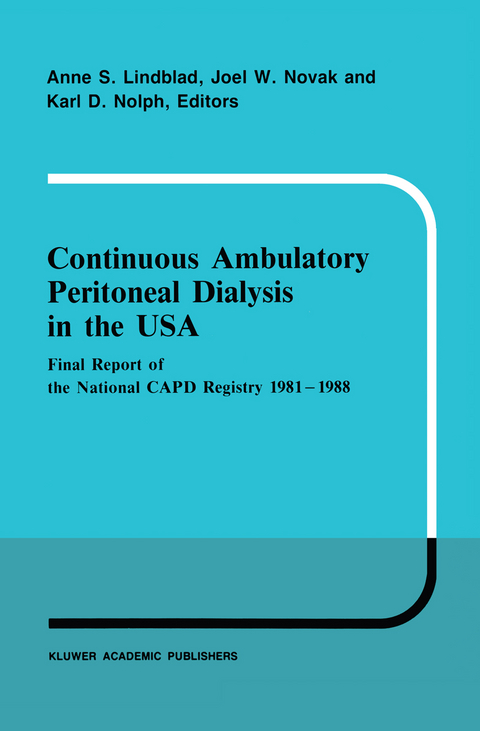
Continuous Ambulatory Peritoneal Dialysis in the USA
Springer (Verlag)
978-94-010-6908-3 (ISBN)
Section 1 Introduction.- Section 2 Registry Patient Population.- Section 3 Patient Characteristics.- Section 4 Complications of Treatment.- Section 5 Termination of Continuous Peritoneal Dialysis.- Section 6 Special Reports—1988.- Section 7 Special Reports—1987.- Section 8 Special Reports—1986.- Section 9 Special Report—1985.- Section 10 Special Report—1984.- Appendices.- I. Executive Advisory Committee of the National CAPD Registry of the National Institutes of Health.- II. Participating Centers of the National CAPD Registry of the National Institutes of Health.- III. Bibliography of the National CAPD Registry of the National Institutes of Health.- Table of Exhibits.- Section 2 Registry Patient Population.- Exhibit 2-1 Number of Patients Registered by Class and Type of Dialysis.- 2-2 Number of Patients Registered by Class and Year of Registration.- 2-3 Number of Patients with Follow-up by Class and Type of Dialysis.- 2-4 Last Contact and Status According to Activity Classification of Center for Patients Last Reported to be on CAPD/CCPD.- 2-5 Currency of The National CAPD Registry Database by Class of Patient.- 2-6 Number of Patients Receiving CAPD at Year End.- 2-7 Census and Flow of The National CAPD Registry by Year.- Section 3 Patient Characteristics.- Exhibit 3-1 Percent of Patients with Selected Characteristics by Type of Therapy.- 3-2 CAPD—Age Distribution by Sex.- 3-3 CCPD—Age Distribution by Sex.- 3-4 CAPD—Age Distribution by Race.- 3-5 CCPD—Age Distribution by Race.- 3-6 CAPD—Distribution of Patients by Primary Renal Disease Type According to Year of Registration.- Section 4 Complications.- Exhibit 4-1 CAPD—Occurrence of Selected Complications by Class of Patients.- 4-2 CAPD—Cumulative Probability of Experiencing First Episode ofPeritonitis (Class 1 Patients Only).- 4-3 CAPD—Complication Rates by Year of Registration.- 4-4 CAPD—Cumulative Probabilities and 95% Confidence Intervals (C.I.) of Experiencing Selected Events for the First Time by Year Registered (Class 1 Patients Only).- 4-5 CAPD—Cumulative Probability of Experiencing First Exit Site/Tunnel Infection (Class 1 Patients Only).- 4-6 CAPD—Cumulative Probability of First Catheter.- Replacement (Class 1 Patients Only).- 4-7 CAPD—Cumulative Probability of First Complication (Class 1 Patients Only).- 4-8 CCPD—Occurrence of Selected Complications by.- Class of Patient.- 4-9 CCPD—Cumulative Probabilities and 95% Confidence Intervals (C.I.) of Experiencing Selected Events for the First Time by Number of Months on CCPD (Class 1 Patients Only).- Section 5 Termination of Continuous Peritoneal Dialysis.- Exhibit 5-1 CAPD—Cumulative Probability of Transfer (Class 1 Patients Only).- 5-2 CAPD—Cumulative Probability of Receiving a Kidney Transplant (Class 1 Patients Only).- 5-3 CAPD—Cumulative Probability of Death (Class 1 Patients Only).- 5-4 CAPD—Cumulative Probability of Discontinuing CAPD Therapy for any Reason (Class 1 Patients Only).- 5-5 CCPD—Cumulative Probability of Transfer (Class 1 Patients Only).- 5-6 CCPD—Cumulative Probability of Receiving a Kidney Transplant (Class 1 Patients Only).- 5-7 CAPD—Cumulative Probability of Death (Class 1 Patients Only).- 5-8 CCPD—Cumulative Probability of Discontinuing CCPD Therapy for Any Reason (Class 1 Patients Only).- 5-9 CAPD or CCPD—Cumulative Probability of Transplantation: Pediatrics vs. ‘Standard’ vs. ‘Other’.- 5-10 CAPD or CCPD—Cumulative Probability of.- Death: Pediatrics vs. ‘Standard’ vs. ‘Other’.- 5-11 CAPD or CCPD—Cumulative Probability of‘Technique Failure’: Pediatrics vs. ‘Standard’ vs. ‘Other’.- 5-12 Follow-up of Transfers to Hemodialysis Summary.- 5-13 Primary Reason for Leaving CAPD in Patients who Transferred from CAPD to Hemodialysis and Subsequently Returned to CAPD.- 5-14 Follow-up of Kidney Transplant Summary.- 5-15 Death Summary.
| Reihe/Serie | Developments in Nephrology ; 23 |
|---|---|
| Zusatzinfo | 272 p. |
| Verlagsort | Dordrecht |
| Sprache | englisch |
| Maße | 155 x 235 mm |
| Themenwelt | Sachbuch/Ratgeber ► Natur / Technik ► Garten |
| Medizinische Fachgebiete ► Innere Medizin ► Nephrologie | |
| Studium ► Querschnittsbereiche ► Epidemiologie / Med. Biometrie | |
| Studium ► Querschnittsbereiche ► Prävention / Gesundheitsförderung | |
| ISBN-10 | 94-010-6908-5 / 9401069085 |
| ISBN-13 | 978-94-010-6908-3 / 9789401069083 |
| Zustand | Neuware |
| Haben Sie eine Frage zum Produkt? |
aus dem Bereich


